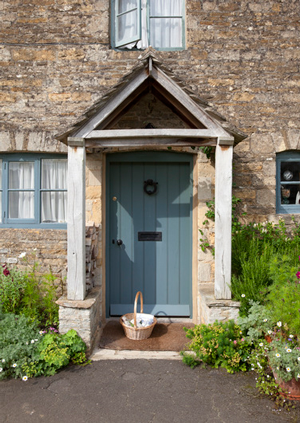Drought Praise: 3 Low-Water Plants for a Fragrant Walkway

Fragrant Salvias and companion plants are excellent choices for entryways. Drought-tolerant plants from naturally dry climates, such as the three featured here, often have a pleasant, resinous fragrance.
At Flowers by the Sea, we've decided that the best way to promote water conservation doesn't involve embarrassing people on social media about their landscaping or watering mistakes. Instead, we're posting "drought praise" introducing you to some of our favorite xeric (low water) plants.
Perfumes from Dry Lands
Dry lands often produce aromatic plants. Here are three choices that these are particularly good for the naturally dry West during this time of prolonged drought.
Pozo Blue from California Chaparral. Similar to commercial perfumes, which mix an array of botanicals, the native plants of California's coastal scrublands (chaparral) form a complicated combination of heady scents.
Cleveland Sage (Salvia clevelandii) and California Purple Sage (S. leucophylla) -- also called California Gray Sage -- are two examples that merge in the powerfully fragrant Grey Musk Sage (Salvia x 'Pozo Blue'), which is a medium height back-of-border choice or a fine groundcover.
Las Pilitas Nursery, which is famous for its work with California native plants, developed this hybrid, which it named for the old stagecoach-stop town of Pozo in San Luis Obispo County on the central coast.
Cooking Sage from the Mediterranean. California's dry summer/wet winter climate is similar to that of the Mediterranean, which is home to aromatic cooking herbs including the ornamental Greek Sage (S. fruticosa). Short, shrubby, and fragrant, it's ideal for front of border.
Sage from the Middle East. You can put together a trio of fragrant plants for a sunny entryway by adding the petite, Middle Eastern Jerusalem Sage (S. hiersolymitana). Instead of aromatic leaves, this plant is known for the fragrance of its flower buds, bracts and stems.
Arabs often use these basal leaves as food wraps, similar to grape leaves.
Intoxicating Scents and Memories
Psychological research has shown that memories of people, places and events often are connected to fragrances and flavors experienced in childhood.
We don't have to leave all pleasant associations to chance. Instead, we can plant fragrant Salvias and companion plants along entryway walks, by front porches, and near decks to welcome all.
Brushing past these plants, rubbing bits between our fingers or inhaling their scent on a warm breezy day is soothing. In time, these fragrances may become the stuff of intoxicating memory.
Here are more details on the trio we suggest.
Front of Border
Greek Sage (Salvia fruticosa) Zones 8 to 9
- Lavender to pink flowers bloom spring to fall
- Mid-green foliage smells like lavender
- 36 inches tall and 18 inches wide in bloom
- Full sun
- Heat tolerant shrub
- Butterflies, honeybees, hummingbirds
Jerusalem Sage (Salvia hierosolymitana) Zones 8 to 11
- Clear mulberry and pale pink flowers bloom in spring
- Fragrant buds, bracts and stems
- Large, fuzzy, deep green, basal foliage without fragrance
- 24 inches tall and 18 inches wide in bloom
- Full sun
- Heat-tolerant perennial
- Honeybees
Back of Border
Grey Musk Sage (Salvia x 'Pozo Blue') Zones 8 to 9
- Lavender flowers bloom spring to summer
- Fragrant gray-green foliage
- 48 inches tall and 36 inches wide in bloom
- Full Sun
- Heat-tolerant shrub
- Honeybees and hummingbirds
- Hybrid of Salvia clevelandii and S. leucophylla
Questions about Drought and Fragrance
Drought-resistant gardening is one of our specialties at FBTS. This has caused us to become acquainted with many aromatic species. If you have any questions about plants for drought, fragrance or any of the choices in our online-only catalog, please call or send us an email. We're glad to share what we know.

 Salvia hierosolymitana
Salvia hierosolymitana  Salvia x 'Pozo Blue'
Salvia x 'Pozo Blue'
Comments
There are no comments yet.